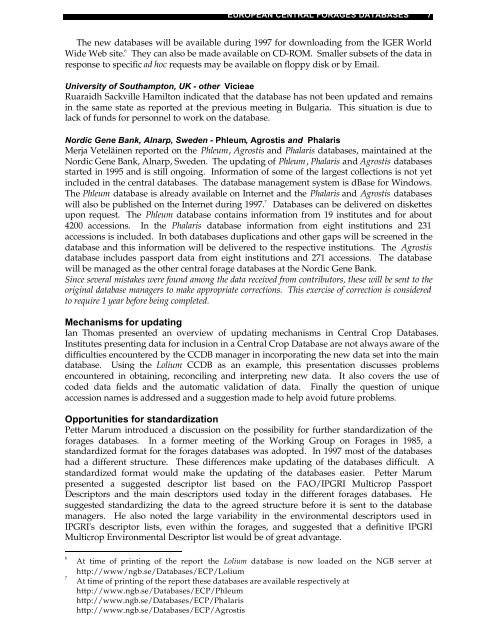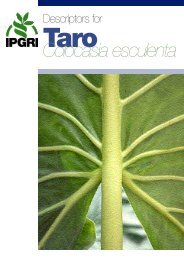Download PDF (6215 kb) - Bioversity International
Download PDF (6215 kb) - Bioversity International
Download PDF (6215 kb) - Bioversity International
Create successful ePaper yourself
Turn your PDF publications into a flip-book with our unique Google optimized e-Paper software.
EUROPEAN CENTRAL FORAGES DATABASES 7<br />
The new databases will be available during 1997 for downloading from the IGER World<br />
Wide Web site. 6 They can also be made available on CD-ROM. Smaller subsets of the data in<br />
response to specific ad hoc requests may be available on floppy disk or by Email.<br />
University of Southampton, UK - other Vicieae<br />
Ruaraidh Sackville Hamilton indicated that the database has not been updated and remains<br />
in the same state as reported at the previous meeting in Bulgaria. This situation is due to<br />
lack of funds for personnel to work on the database.<br />
Nordic Gene Bank, Alnarp, Sweden - Phleum, Agrostis and Phalaris<br />
Merja Veteläinen reported on the Phleum, Agrostis and Phalaris databases, maintained at the<br />
Nordic Gene Bank, Alnarp, Sweden. The updating of Phleum, Phalaris and Agrostis databases<br />
started in 1995 and is still ongoing. Information of some of the largest collections is not yet<br />
included in the central databases. The database management system is dBase for Windows.<br />
The Phleum database is already available on Internet and the Phalaris and Agrostis databases<br />
will also be published on the Internet during 1997. 7 Databases can be delivered on diskettes<br />
upon request. The Phleum database contains information from 19 institutes and for about<br />
4200 accessions. In the Phalaris database information from eight institutions and 231<br />
accessions is included. In both databases duplications and other gaps will be screened in the<br />
database and this information will be delivered to the respective institutions. The Agrostis<br />
database includes passport data from eight institutions and 271 accessions. The database<br />
will be managed as the other central forage databases at the Nordic Gene Bank.<br />
Since several mistakes were found among the data received from contributors, these will be sent to the<br />
original database managers to make appropriate corrections. This exercise of correction is considered<br />
to require 1 year before being completed.<br />
Mechanisms for updating<br />
Ian Thomas presented an overview of updating mechanisms in Central Crop Databases.<br />
Institutes presenting data for inclusion in a Central Crop Database are not always aware of the<br />
difficulties encountered by the CCDB manager in incorporating the new data set into the main<br />
database. Using the Lolium CCDB as an example, this presentation discusses problems<br />
encountered in obtaining, reconciling and interpreting new data. It also covers the use of<br />
coded data fields and the automatic validation of data. Finally the question of unique<br />
accession names is addressed and a suggestion made to help avoid future problems.<br />
Opportunities for standardization<br />
Petter Marum introduced a discussion on the possibility for further standardization of the<br />
forages databases. In a former meeting of the Working Group on Forages in 1985, a<br />
standardized format for the forages databases was adopted. In 1997 most of the databases<br />
had a different structure. These differences make updating of the databases difficult. A<br />
standardized format would make the updating of the databases easier. Petter Marum<br />
presented a suggested descriptor list based on the FAO/IPGRI Multicrop Passport<br />
Descriptors and the main descriptors used today in the different forages databases. He<br />
suggested standardizing the data to the agreed structure before it is sent to the database<br />
managers. He also noted the large variability in the environmental descriptors used in<br />
IPGRI's descriptor lists, even within the forages, and suggested that a definitive IPGRI<br />
Multicrop Environmental Descriptor list would be of great advantage.<br />
6<br />
At time of printing of the report the Lolium database is now loaded on the NGB server at<br />
http://www/ngb.se/Databases/ECP/Lolium<br />
7<br />
At time of printing of the report these databases are available respectively at<br />
http://www.ngb.se/Databases/ECP/Phleum<br />
http://www.ngb.se/Databases/ECP/Phalaris<br />
http://www.ngb.se/Databases/ECP/Agrostis




